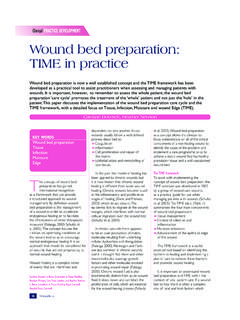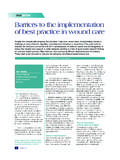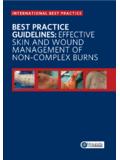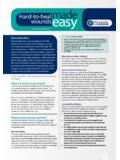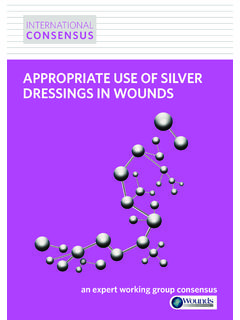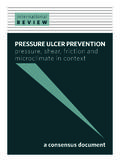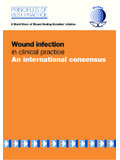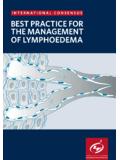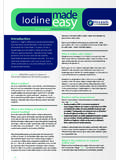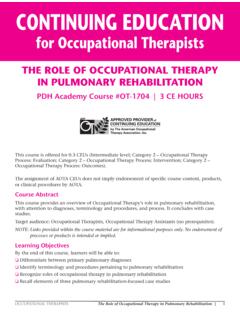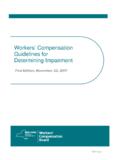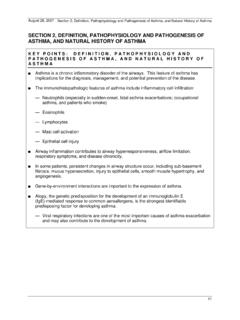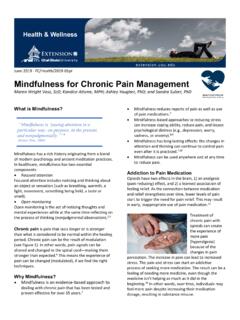Transcription of Role of collagen in wound management
1 54 Clinical REVIEWW ounds uk, 2011, Vol 7, No 2 Role of collagen in wound managementAravindan Rangaraj, Keith Harding, David LeaperAravindan Rangaraj is Clinical Research Fellow; Keith Harding is Head of Section of wound Healing; David Leaper is Visiting Professor; all at Department of Dermatology and wound Healing, School of Medicine, Cardiff University, CardiffCollagen is structurally and functionally a key protein of the extracellular matrix which is also involved in scar formation during the healing of connective tissues. Many collagen dressings have been developed to enhance wound repair, particularly of non-infected, chronic , indolent skin ulcers. The use of collagen dressings is supported by relatively sparse and insufficient scientific data. This review identifies the supporting evidence for the use of the dressings which are available, often with widely different claimed advantages and modes of action, and considers future developments and assessment of collagen dressings.
2 collagen is the unique, triple helix protein molecule, which forms the major part of the extracellular dermal matrix (ECM), together with the glycosaminoglycans, proteoglycans, laminin, fibronectin, elastin and cellular components (Hopkinson, 1992a, b; Berry et al, 1998; Enoch and Leaper, 2008). collagen is the most abundant protein in animal tissues and accounts for 70 80% of the dry weight of the dermis (Hopkinson, 1992a). Mainly produced by fibroblasts, at least 21 genetically distinct collagens have currently been identified, with six of these being present in the skin. collagen type I comprises approximately 70% of collagen in the skin, with type III being 10%, and trace amounts of collagen type IV, V, VI and VII (Uitto et al, 1989; Hay, 1991). 8 Protein synthesis in the extracellular matrix (ECM)8 Synthesis and release of inflammatory cytokines and growth factors8 Interactions between enzymes which remodel the ECM, including matrix metalloproteinases (MMPs) and their tissue inhibitors (TIMPs), which are summarised in Table in chronic wound healingIn chronic wounds involving skin, defined as those which do not heal in optimal conditions within six weeks (Mustoe et al, 2006), the complex interactive processes described above are deranged.
3 Conversely, there is not a lack of normal healing but often hyperactivity which is out of phase, non-progressive, and with a persistent, uncoordinated, mixed acute and chronic inflammatory response (Schultz and Mast, 1998; Trengrove et al, 1999; Hansen et al, 2003; Kim et al, 2003; Diegelmann and Evans, 2004), which has also been well summarised at molecular level (Agren and Werthen, 2007). The most common cause of this hard-to-heal chronicity is infection, which can be hard to define and range from increasing microbial colonisation, which is inevitable in open wounds healing by secondary intention, through to increasing contamination and clinically overt infection. The concept of critical colonisation , or alternatively an excessive local bioburden, which acts as a prequel to infection, is widely accepted KEY WORDSC ollagenWound healingDressingsChronic wounds The principal function of collagen is to act as a scaffold in connective tissue, mostly in its type I, II and III forms.
4 In early healing wounds, type III is laid down first, with the proportion of type I increasing as scar formation progresses and is remodelled. collagen deposition and remodelling contribute to the increased tensile strength of the wound , which is approximately 20% of normal by three weeks after injury, gradually reaching a maximum of 70% of that of normal skin (Desmouliere et al, 1995). Although epithelial structures can heal by regeneration, connective tissues cannot and depend on the process of repair mostly by the formation of collagenous scar tissue (Berry et al, 1998), predominantly of type I, which serves to restore tissue continuity, strength and function. collagen is a brittle substitute for unwounded tissue, and scar tissue rarely exceeds 70% of unwounded tissue strength. In embryos, it has been shown that cutaneous wounds can heal without a scar (Rowlatt et al, 1979; Moulin et al, 2005; Redd et al, 2004), but this has yet to be translated into a tissue engineered alternative solution.
5 In addition to being the main component of scar tissue, collagen has a key role in:8 The control of the inflammatory response to injury and subsequent repair with functions that influence cellular mitogenesis, differentiation and 216/06/2011 12:2156 Clinical REVIEWW ounds uk, 2011, Vol 7, No 2but is not accurately measurable (White and Cutting, 2008). Nevertheless, control of colonisation and infection through local, topical (antiseptics) and systemic (antibiotics) antimicrobials is pivotal to preparation of the wound bed, before wound closure following contraction through formation of healthy granulation tissue and epithelialisation. Other factors critical to the successful preparation of the wound bed include scrupulous debridement of non-viable tissue and foreign material, by all methodologies available (including sharp surgical debridement and topical negative pressure [TNP] therapy) (Wolcott et al, 2009).
6 This can only be achieved in conjunction with optimal holistic care; again through local (such as attention to adequate arterial supply or pressure relief) and systemic (such as diabetic control) interventions. Once these criteria are met, with a prepared wound bed and control of any underlying pathological processes, successful healing can occur. It is at this stage that collagen or collagen -derived dressings may have a role in wound healing with the critical collagen functions listed in Table 1, several other factors relating to poor wound healing, directly affect collagen metabolism. Included among the extrinsic factors is diabetes, in which hyperglycaemia reduces normal collagen production and induces non-enzymatic glycosylation of collagen and keratin, leading to formation of abnormal rigid collagen and adding to tissue breakdown (Black et al, 2003). collagen over production can form abnormal scars, which impede wound healing (Gault, 1999).
7 A chronic wound burden among the elderly has been documented (Wilkinson et al, 1993), and much of this age-related, delayed wound healing is caused by impaired collagen synthesis and increased degradation (Ashcroft et al, 2002). Smoking affects the synthesis rates of collagen , MMP and TIMP1 levels in the skin, leading to imbalances in collagen turnover (Knuutinen et al, 2002). Intrinsic factors include variations in oxygen tension which can alter fibroblast proliferation and collagen production, and also enhance the structural support required for Table 1 Influence of collagen in the inflammatory response to injury8 Cellular differentiation, angiogenesis and mitogenesis8 Protein synthesis and ECM deposition8 Cellular migration (keratinocytes and epithelialisation, fibroblasts, monocyte/ macrophages, neutrophils)8 Induction of collagenases8 wound contraction8 Platelet aggregation and induction clotting cascades8 Induction of growth factors and cytokines through degradation products8 Cell surface receptors (integrins) in cell-signalling and induction of other ECM molecules and proteinsReferences:Doillon and Silver, 1986; Montesano et al, 1983; Albini and Adelman-Grill, 1985; Newman and Tucci, 1990; Petersen et al, 1990; Shaw et al, 1990.
8 Klein et al, 1991; Schiro et al, 1991; Hynes, 1992; Madri and Marx, 1992; Scharfetter-Kochanek et al, 1992; Sudbeck et al, 1994; Krieg, 1995; Clark, 1996; Schultz and Mast, 1998; Pilcher et al, 1997, 1999; Feng et al, 1999; Davis et al, 2000; Steffensen et al, 2001; Armstrong and Jude, 2002; Ruszczak, 2003; Diegelmann and Evans, 2004; Mirastschijski et al, 2004; Schultz et al, 2005; Ulrich et al, 2005; Agren and Werthen, 2007; Cavallini, 2007; Clark et al, 2007; Hodde and Johnson, 2007; DiCosmo, 2009; Schultz and Wysocki, 2009capillary angiogenesis (Hunt and Pai, 1975), and an abnormal excessive local inflammatory response leading to abnormal, hypertrophic or keloid scarring (Wang et al, 2007). collagen dressings in wound managementThe use of collagen dressings may seem attractive in view of their functions to:8 Inhibit or deactivate MMPs8 Increase fibroblast production and permeation8 Aid in the uptake and bioavailability of fibronectin8 Help to preserve leukocytes, macrophages, fibroblasts, and epithelial cells8 Assist in the maintenance of the chemical and thermostatic microenvironment of the wound (Burton et al, 1978; Doillon et al, 1984, 1986, 1988; Palmieri, 1992; Brett, 2008).
9 These data suggest a compelling theoretical role for collagen as a dressing in wound management , but are relatively limited, being derived from experimental data and non-comparative case reports. The use of collagen in wound management has not yet been clearly translated into a platform for widespread clinical use, as these studies only offer evidence for collagen as a dressing matrix and not as an active agent. By comparison, the use of collagen materials as a scaffold in hernia and abdominal wound repair (Holl-Allen, 1984; Buinewicz and Rosen, 2004; Parker et al, 2006; Baillie et al, 2007; Jehle et al, 2007) seems to be clinically and cost-effective, but their use as a dressing in healing indolent chronic skin wounds, healing by secondary intention, has yet to be convincingly proven, despite the fact that there are many such products already available (Table 2). This review looks at the currently available data to explore and substantiate any case for the development and clinical use of collagen sheet dressings, paste or fleece for the stimulation of closure in indolent hard-to-heal chronic wounds.
10 416/06/2011 12:22 Clinical REVIEWSkin, with its inherent epidermis and dermis, provides the ideal cover for any wound . For this reason, a whole range of autologous skin graft techniques are available to replace lost skin, from split-thickness skin grafts to complex pedicle or free microvascular myocutaneous flaps, but these may not be sufficient to cover the widespread skin loss which may occur after extensive burns (Purna and Babu, 2000). All these grafts give primary cover with an optimal chance of healing, and have also been widely used to cover chronic wounds in which healing is stalled despite adequate preparation of the wound bed to optimise closure by secondary intention. Nevertheless, these grafted wounds are at risk of failure or infection (of both donor and recipient sites), with considerable subsequent morbidity. Several techniques have been designed to extend the area of split-thickness grafts available, such as meshing, or to make harvest simpler and accessible, as in pinch grafting, but they still inflict an injury to healthy, intact skin (Horch et al, 2005).
